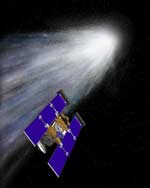
Image credit: NASA
NASA’s Stardust spacecraft has nearly arrived at its first destination, Comet Wild 2. On January 2, 2004, the spacecraft will buzz through the comet’s tail and collect interstellar particles and dust. The particles will be captured on a tennis racket-shaped grid that will ensure they aren’t damaged. Stardust will return the sample to Earth in 2006 so that scientists can analyze it on the ground. It’s believed that comets are as old as the solar system, so analyzing these particles will reveal valuable information about our origins.
On January 2nd 2004 the NASA space mission, STARDUST, will fly through comet Wild 2, capturing interstellar particles and dust and returning them to Earth in 2006. Space scientists from the Open University and University of Kent have developed one of the instruments which will help tell us more about comets and the evolution of our own solar system and, critical for STARDUST, its survival in the close fly-by of the comet.
Launched in February 1999, STARDUST is the first mission designed to bring samples back from a known comet. The study of comets provides a window into the past as they are the best preserved raw materials in the Solar System. The cometary and interstellar dust samples collected will help provide answers to fundamental questions about the origins of the solar system.
Scientists from the Open University and University of Kent have developed one set of sensors for the Dust Flux Monitor Instrument (DFMI) built by the University of Chicago, and the software to analyse the data. The DFMI, part funded by the Particle Physics and Astronomy Research Council (PPARC) will record the distribution and sizes of particles on its journey through the centre, or coma, of the comet.
Professor Tony McDonnell and Dr Simon Green from the Open Universitys Planetary and Space Science Research Institute (PSSRI), will be at the mission command centre, the Jet Propulsion Laboratory in California, when the encounter with Wild 2 begins.
Dr Green explains By combining the information about each of the tiny grains of dust captured by STARDUST we will discover more about the formation of stars, planets and our solar system.
Professor Tony McDonnell said The information derived from the signals will tell us on the night if the dust shield has been critically punctured.
Cometary particles will be captured on a tennis racket like grid which contains a substance called aerogel the lightest solid in the Universe! This is a porous material that allows the particles to become embedded with minimum damage. This means that on their return to Earth they will be as near as possible to their original state.
Once the samples are captured a clam-like shell closes around them. The capsule then returns to Earth in January 2006 where it will land at the US Air Force Utah Test and Training Range. Once collected, the samples will be taken to the planetary material curatorial facility at NASAs Johnson Space Centre, Houston, where they will be carefully stored and examined.
The Open University team hope to be involved in analysing the samples that return to Earth in January 2006.
UK scientists, including a team from the Open University, are also involved with the European Space Agencys Rosetta Mission which will follow and land on Comet Churyumov-Gerasimenko. This mission is due to be launched on 26th February 2004.
Original Source: PPARC News Release
